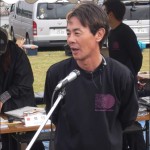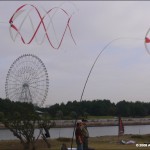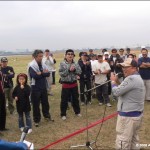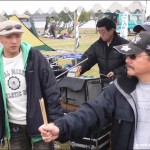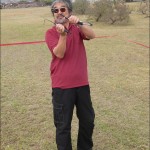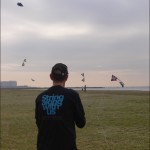I’d put away my fleece jacket and wind-proofs after the STACK Eurocup at Scheveningen in September, but was delighted to dig them out again following a surprise invitation from AJSKA to join in the fun at the Tokyo Bay Flight Party (TBFP), held over the weekend of 15/16 November. A long way to go to judge a sport-kite competition? Maybe, but an opportunity not to be missed. Have Rule-Book – Will Travel!
The venue for the competition was the lovely Kasai Rinkai Park on the outskirts of Tokyo; more specifically on a smallish island of reclaimed land on the seaward side of the park. With hazy views of distant Tokyo and a backdrop of the huge Kasai Ferris Wheel and Tokyo Disney World, the site could hardly have been more perfect.
The competition control marquees were rapidly erected and the sound system was up and running in short order. Contestants had traveled from all over Japan, including Hokkaido in the far North (a two hour flight from Tokyo). Also competing were a party of very capable kiteflyers from Taiwan. AJSKA President Seiji Kato (Kato-san) set proceedings in motion with a speech that I couldn’t follow but soon had everyone laughing. Briefings followed a familiar pattern, though the draw for flight order had a uniquely Japanese flavour with competitors picking from a fist-full of numbered chopsticks!
The individual disciplines of the Japan Cup competition which formed part of the TBFP were flown to an experimental format. Several pieces of similar background music, each of 2 minutes duration, had been chosen by the organisers. Competitors performed a technical routine against the background music, incorporating two previously nominated compulsory figures into their routines. Competitors were awarded an overall performance score, independently from the separate scores for the figures, however, because each competitor would be allocated a different piece of music, this was not intended to be a score for choreography.
I found this experimental format easier to judge than I had expected. Thanks to “in” and “out” calls for each compulsory element, there was no problem in identifying when these were being initiated. Only one score was required for each figure so it was simple enough to do this without having to look down at the score sheet. All the competitors were able to execute identifiable figures, which were mostly of good quality and definition and were fitted neatly into their short technical routines. The competitors that I spoke to said, without exception, that they found the format challenging and fun to fly. One commented “it gives you the experience of flying a ballet while teaching the skills of putting maneuvers together to create a routine”. Some food for thought here!
I didn’t judge the multi-line individual class but as a spectator, I found it very enjoyable to watch. Flying to background music appeared as a more purposeful exercise, and provides a better spectacle without the need for any explanation beyond being “a short routine incorporating some compulsory elements”. Certainly spectators knew when to express their appreciation, which must have been rewarding for the competitors.
Winds were very light throughout both days, but with banners hanging limply from their poles, competitors continued flying in winds that there were hardly there. I asked my interpreter, Gary Ikebe, why flyers were not asking for wind-checks. His answer? “It’s probably a bit of a bushido-thing. The conditions are the same for everyone, we want to have a competition and there’s no point in holding up progress. Light winds are something we learn to live with”. If I hadn’t seen it with my own eyes, I wouldn’t have believed it possible to fly in these conditions, but fly they did. The best routines had clearly been built with light airs in mind; sharp, powerful, well-defined moves while walking backward contrasting with light floaty tricks while regaining ground. Most Impressive!
The other thing that I must mention was the quality and numbers of contestants taking part in multiline disciplines. There was some awesome flying, especially among the pairs and teams that seem, sadly, to be dwindling in Europe. I believe there were 6 contestants in the team competition, one of which fielded 13 flyers and another 8. Winners, Team Rising deserve a special mention for a wonderfully tight and precise routine, with well-held formations all elegantly choreographed to their music.
It was a pleasure to meet again with WSKC 2006 co-judge John Barresi, who totally wowed everyone with his demonstrations. I’m also delighted to announce that John is now engaged to be married to the lovely Takako Kishi, a regular flier on the Tokyo kite scene. Congratulations both! Takako is a pretty sharp flyer herself, and they really do make a great couple.
The Rev megafly was truly spectacular; forty-plus very capable rev flyers performing in choreographed harmony, thanks to the masterplan devised and “conducted” (it’s the only word to describe it) by Hosoya Yoshihisa. Such was the quality of the Rev flying, your correspondent had to try for himself and Yes, Santa, I now wanna B-Series Pro for Christmas (but will need some lessons!)
Saturday night saw the gala-buffet and kite auction. After the meal and a few beers, chief-organizer Takamatsu Mikio introduced all the team who had helped to put the event together; also introduced were Kato-san, the Taiwanese flyers, John Barresi and myself. Thanks to a little homework and a Japanese phrase book, I was able to tell the gathering, in Japanese, that I was NOT able to speak Japanese! (useful stuff in these phrase books). We also received a visit from Modegi Masaaki (Modegi-san) the much-loved and revered Chairman of the Japanese Kite Association.
The kite auction was something to behold. The formula for the smaller lots was straightforward and the bidding was in amounts where no-one could feel uncomfortable. However there were some very nice kites on offer where the formula was to pay say 1000 yen (around $10 US, 8 euros or £6 sterling) to enter the auction. No further investment was required as the winner was then decided by enthusiastic multiple rounds of paper/scissors/stone accompanied by the traditional cry of “Saisho wa gu, Janken pon! Again, totally infectious and uniquely Japanese.
Calling this event a Flight Party is no idle boast, it really was a party atmosphere from start to finish, with everyone in great good humour and contributing to the proceedings. It may not be the worlds’ biggest festival, but it’s well in contention for the friendliest.
Waiting to go back next year…
Andy Taylor


